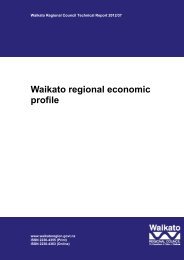Enviroschools Newsletter no. 11 - May 2007 - Waikato Regional ...
Enviroschools Newsletter no. 11 - May 2007 - Waikato Regional ...
Enviroschools Newsletter no. 11 - May 2007 - Waikato Regional ...
You also want an ePaper? Increase the reach of your titles
YUMPU automatically turns print PDFs into web optimized ePapers that Google loves.
Scenario 1: Teachers (and students) think rubbish is a problem in the school. The school incinerator needs to be decommissioned. It<br />
costs a lot to pay for a rubbish skip.<br />
Issue: Is there a need to do something about the existing waste management methods<br />
Action: Teachers and students of a senior syndicate, or class, plan a zero waste unit.<br />
Education in the<br />
environment<br />
A waste audit is completed by a class or Envirogroup. Data is recorded and shared with the rest of the<br />
school at a school assembly or display. Carry out activities from the zero waste section of the <strong>Enviroschools</strong><br />
kit.<br />
Education about the<br />
environment<br />
Visit a local transfer station to investigate what happens to rubbish in the community.<br />
Investigation about reducing, recycling and reusing resources. Carry out experiments and activities from<br />
building science concepts booklets about recycling and rubbish.<br />
Research organic and i<strong>no</strong>rganic materials. This leads to an understanding about classification and sorting<br />
of different types of waste.<br />
Write letters to the local council or community providers to ask about their services.<br />
Research about decomposition, worms and composting methods.<br />
Education for the<br />
environment<br />
Organise a visit from a community expert. This might lead to k<strong>no</strong>wledge about different ways of dealing<br />
with waste. Search through the <strong>Enviroschools</strong> scrapbooks to see what other schools have done. Visit or<br />
email a<strong>no</strong>ther school to find out more information about an action project.<br />
Students complete an action plan to develop a paper recycling system. They design a whole school system<br />
for sorting rubbish into different categories. Permission gained from school’s management. Students<br />
fundraise to pay for containers or bins by selling calico shopping bags. A design group makes labels for<br />
the different categories. Paper, plastics and food recycling is trialled within a class or syndicate. A<strong>no</strong>ther<br />
group makes a video to explain methods and systems for sorting and collection. The students monitor<br />
and evaluate the process and communicate ideas at a school assembly or with buddy classes. They write<br />
instructions for class <strong>no</strong>tices and introduce the recycling system school wide using a roster management<br />
system. They aim to reduce resource use and develop a sustainable system. An article about food<br />
packaging is written for the school newsletter to share learning with the school community.<br />
Scenario 2: As part of a whole school vision process, students recognise that there are <strong>no</strong>t many native trees within the school grounds.<br />
The students would like to encourage the native birds to visit their school. With support from teachers they learn about the native plants<br />
that grow naturally in their area. After a lot of discussion and consultation with their community they decide they could use an area of<br />
school land for a bush. They seek help from an expert who helps them learn about seed collection from a nearby reserve. Students use<br />
books to identify plants. A group of parents help them to plant the seeds. These are nurtured over years by these and subsequent<br />
students. Young trees and shrubs (grown, purchased and donated) are planted in autumn.<br />
Education in the<br />
environment<br />
Education about the<br />
environment<br />
Students carry out experiential activities from the living landscape section of the <strong>Enviroschools</strong> kit. They visit<br />
a local reserve and investigate plants and bush communities (the biodiversity of native bush ecosystems).<br />
They observe changes in the plant from seed to seedling, and then growth over the years.<br />
Students investigate the diversity of organisms (plants, birds and insects) that are special to their area using<br />
books and field guides. They learn how seeds grow and become trees. They learn how to differentiate<br />
between common plant features.<br />
Education for the<br />
environment<br />
Students discuss the impact man and introduced animals have had on our bush and birds. An article in<br />
the local newspaper about releasing a kiwi pair into a reserve stimulates discussion about why we need to<br />
protect and restore native areas. They research how some species have become endangered.<br />
Students, supported by teachers and the local community, design and plan an area of bush to be planted<br />
on school land. They use an action planner to help them decide what needs to be done, what is needed to<br />
do it and who needs to be involved. They collect yoghurt pots and ice-cream containers to reuse as pots.<br />
They apply for a permit to collect seeds. They fundraise and apply for grants. They decide on a timeline for<br />
actions. They write articles for the school newsletter asking for help. They are involved in a community<br />
planting day. They accept responsibility for ongoing care of the plants.<br />
By providing opportunities for all three of the key dimensions young people will be able to develop the k<strong>no</strong>wledge, skills and<br />
attitudes to become confident leaders in sustainability. Collaborative planning for a range of approaches to teaching and learning<br />
will help foster sustainable decision making in all areas school life.

















